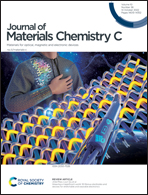A self-driven wideband wavelength sensor based on an individual PdTe2/Thin Si/PdTe2 heterojunction†
Abstract
In this work, we report on a sensitive wavelength sensor composed geometrically of an individual PdTe2/thin Si/PdTe2 heterojunction that is able to quantitatively discriminate incident light wavelengths spanning from the deep-ultraviolet to the near-infrared spectrum. The prominent photovoltaic activity of the heterojunction endows the device with the ability to work in the absence of extrinsic power supply. Owing to the wavelength-dependent optical absorption characteristics as well as the distance-related charge carrier recombination behavior, the heterojunction device exhibits deep contrast in the distribution of photo-generation rate relative to the junction area and different recombination activities in photocarriers, upon light irradiation with varied wavelengths from opposite directions. As a consequence, it shows completely different spectral photoresponses in front-illuminated and back-illuminated modes. Therefore, the corresponding photocurrent ratio of the device versus incident light wavelength can be numerically depicted through a monotone function, via which one can accurately discriminate the wavelength spanning from 265 to 1050 nm with an average absolute error of below 10 nm. This work paves an effective avenue for developing highly sensitive wavelength sensors, which hold enormous promise in future photoelectrical devices and systems.



 Please wait while we load your content...
Please wait while we load your content...